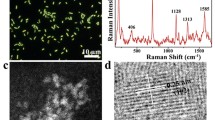Abstract
The potential toxicity of nanoparticles to aquatic organisms is of interest given that increased commercialization will inevitably lead to some instances of inadvertent environmental exposures. Cadmium selenide quantum dots (QDs) capped with zinc sulfide are used in the semiconductor industry and in cellular imaging. Their small size (<10 nm) suggests that they may be readily assimilated by exposed organisms. We exposed Daphnia magna to both red and green QDs and used synchrotron X-ray fluorescence to study the distribution of Zn and Se in the organism over a time period of 36 h. The QDs appeared to be confined to the gut, and there was no evidence of further assimilation into the organism. Zinc and Se fluorescence signals were highly correlated, suggesting that the QDs had not dissolved to any extent. There was no apparent difference between red or green QDs, i.e., there was no effect of QD size. 3D tomography confirmed that the QDs were exclusively in the gut area of the organism. It is possible that the QDs aggregated and were therefore too large to cross the gut wall.




Similar content being viewed by others
References
Medintz IL, Mattoussi H, Clapp AR (2008) Potential clinical applications of quantum dots. Int J Nanomedicine 3:151–167
Sanvicens N, Marco MP (2008) Multifunctional nanoparticles—properties and prospects for their use in human medicine. Trends Biotechnol 26:425–433
Zhang H, Yee D, Wang C (2008) Quantum dots for cancer diagnosis and therapy: biological and clinical perspectives. Nanomedicine 3:83–91
Hardman R (2006) A toxicologic review of quantum dots: toxicity depends on physicochemical and environmental factors. Environ Health Perspect 114:165–172
Kirchner C, Liedl T, Kudera S, Pellegrino T, Javier AM, Gaub HE, Stolzle S, Fertig N, Parak WJ (2005) Cytotoxicity of colloidal CdSe and CdSe/ZnS nanoparticles. Nano Lett 5:331–338
Derfus AM, Chan WCW, Bhatia SN (2004) Intracellular delivery of quantum dots for live cell labeling and organelle tracking. Adv Mater 16:961
Derfus AM, Chan WCW, Bhatia SN (2004) Probing the cytotoxicity of semiconductor quantum dots. Nano Lett 4:11–18
Hoshino A, Fujioka K, Oku T, Nakamura S, Suga M, Yamaguchi Y, Suzuki K, Yasuhara M, Yamamoto K (2004) Quantum dots targeted to the assigned organelle in living cells. Microbiol Immunol 48:985–994
Zhang HZ, Huang F, Gilbert B, Banfield JF (2003) Molecular dynamics simulations, thermodynamic analysis, and experimental study of phase stability of zinc sulfide nanoparticles. J Phys Chem B 107:13051–13060
Bouldin JL, Ingle TM, Sengupta A, Alexander R, Hannigan RE, Buchanan RA (2008) Aqueous toxicity and food chain transfer of quantum Dots (TM) in freshwater algae and Ceriodaphnia dubia. Environ Toxicol Chem 27:1958–1963
Shaw JR, Dempsey TD, Chen CY, Hamilton JW, Folt CL (2006) Comparative toxicity of cadmium, zinc, and mixtures of cadmium and zinc to daphnids. Environ Toxicol Chem 25:182–189
Heinlaan M, Ivask A, Blinova I, Dubourguier HC, Kahru A (2008) Toxicity of nanosized and bulk ZnO, CuO and TiO2 to bacteria Vibrio fischeri and crustaceans Daphnia magna and Thamnocephalus platyurus. Chemosphere 71:1308–1316
Phipps GL, Mattson VR, Ankley GT (1995) Relative sensitivity of 3 fresh-water benthic macroinvertebrates to 10 contaminants. Archives Environ Contam Toxicol 28:281–286
Sibley PK, Ankley GT, Cotter AM, Leonard EN (1996) Predicting chronic toxicity of sediments spiked with zinc: an evaluation of the acid-volatile sulfide model using a life-cycle test with the midge Chironomus tentans. Environ Toxicol Chem 15:2102–2112
Ingersoll CG, Dwyer FJ, May TW (1990) Toxicity of inorganic and organic selenium to Daphnia-magna (Cladocera) and Chironomus-Riparius (Diptera). Environ Toxicol Chem 9:1171–1181
Beaty TV, Hendricks AC (2001) The relationship of Chironomus riparius larval Se body burden and body concentration to larval dry mass and effects on sensitivity to selenium. Environ Toxicol Chem 20:1630–1640
Ingle TM, Alexander R, Bouldin J, Buchanan RA (2008) Absorption of semiconductor nanocrystals by the aquatic invertebrate Ceriodaphnia dubia. Bull Environ Contam Toxicol 81:249–252
Jackson BP, Williams PL, Lanzirotti A, Bertsch PM (2005) Evidence for biogenic pyromorphite formation by the nematode Caenorhabditis elegans. Environ Sci Technol 39:5620–5625
De Samber B, Silversmit G, Evens R, De Schamphelaere K, Janssen C, Masschaele B, Van Hoorebeke L, Balcaen L, Vanhaecke F, Falkenberg G, Vincze L (2008) Three-dimensional elemental imaging by means of synchrotron radiation micro-XRF: developments and applications in environmental chemistry. Anal Bioanal Chem 390:267–271
De Samber B, Evens R, De Schamphelaere K, Silversmit G, Masschaele B, Schoonjans T, Vekemans B, Janssen CR, Van Hoorebeke L, Szaloki I, Vanhaecke F, Falkenberg G, Vincze L (2008) A combination of synchrotron and laboratory X-ray techniques for studying tissue-specific trace level metal distributions in Daphnia magna. J Anal Atom Spectrosc 23:829–839
Gophen M, Geller W (1984) Filter mesh size and food particle uptake by daphnia. Oecologia 64:408–412
Fox HM (1952) Anal and oral intake of water by Crustacea. J Exp Biol 29:583–599
Kim SA, Punshon T, Lanzirotti A, Li LT, Alonso JM, Ecker JR, Kaplan J, Guerinot ML (2006) Localization of iron in Arabidopsis seed requires the vacuolar membrane transporter VIT1. Science 314:1295–1298
Xu XHN, Brownlow WJ, Kyriacou SV, Wan Q, Viola JJ (2004) Real-time probing of membrane transport in living microbial cells using single nanoparticle optics and living cell imaging. Biochemistry 43:10400–10413
Kloepfer JA, Mielke RE, Nadeau JL (2005) Uptake of CdSe and CdSe/ZnS quantum dots into bacteria via purine-dependent mechanisms. App Environ Microbiol 71:2548–2557
Acknowledgments
This work was supported by US EPA RD-83332401-0 to BJ and JR. The work was performed at Beamlines X27A and X26A, National Synchrotron Light Source (NSLS), Brookhaven National Laboratory. Beamline X26A is supported by the Department of Energy (DOE)-Geosciences (DE-FG02-92ER14244 to The University of Chicago-CARS). Use of the NSLS and Beamline X27A was supported by DOE under contract no. DE-AC02-98CH10886.
Author information
Authors and Affiliations
Corresponding author
Rights and permissions
About this article
Cite this article
Jackson, B.P., Pace, H.E., Lanzirotti, A. et al. Synchrotron X-ray 2D and 3D elemental imaging of CdSe/ZnS quantum dot nanoparticles in Daphnia magna . Anal Bioanal Chem 394, 911–917 (2009). https://doi.org/10.1007/s00216-009-2768-y
Received:
Revised:
Accepted:
Published:
Issue Date:
DOI: https://doi.org/10.1007/s00216-009-2768-y




